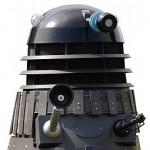Half blind dovetails scribe lines
Welcome! / Forums / General Woodworking Discussions / Woodworking Methods and Techniques / Half blind dovetails scribe lines
Tagged: Half blind dovetails
- This topic has 7 replies, 6 voices, and was last updated 3 years, 12 months ago by
 Bryan Barrick.
Bryan Barrick.
-
AuthorPosts
-
 24 March 2020 at 2:23 am #654229
24 March 2020 at 2:23 am #654229Quick question. What does everyone use for scribing the pins on your dovetails? I currently use a double beveled blade. The same knife Paul uses. I’m struggling with half blind dovetails. I’m always stopping a hair short of my actual scribe line in my tails in order to get a nice fit. Is this my scribing technique? Do others have to do the same? I am very, very careful to not bruise and move the scribe line while sneaking up on it. I’m assuming my very last cut with the chisel should be able to go right into the scribe as long as I’m taking off a very small amount and still have a tight fit.
24 March 2020 at 10:54 am #654307There are at least 4 (free) video series showing half-lap dovetail
– workbench customisations – drawer: episode 2 (the one I looked at for my first drawer and which was successful);
– desktop organiser: episode 4;
– drawer making: episode 1;
– half-lap dovetail.
It might be worth reviewing each one.
Each has its own gem.Sounds like a knife line marking problem. I assume you cut your tails on one board, hold that board against your pin board and then scribe around each tail to mark out the slots on the pin board. If I follow, you are saying that when you cut out the slots on your pin board for the half blind dovetails, you have to cut a hair shy of the scribe line. If you cut right to the scribe lines, your joint is too loose. If that is what is going on, it means you are not getting your scribe line tight enough to the tail. Teh question is why. Paul sometimes talks about marking things as if you were trying to reach under the piece of wood (here the tail) with your knife tip. Actually, I suppose you do get the slightest bit under, though just a fraction of a fraction of a fraction of a mil! It is so little that it is almost like imagining it going under. If you go too far, the joint will be too tight of course. But if your knife feels like you are going straight down (that is, not the slightest almost imaginary bit under) you will probably be too loose. So my guess is that your knife blade is too vertical rather than sort of reaching that slight almost imaginary bit under the tail.
But keep two related things in mind. First the bevel of your knife can get in the way, It can really throw a joint off if you let it. You need to get the tip of your knife in there without letting the bevel of the knife push the tip out. Second, even if the bevel is not a problem, the knife blade itself has width. The deeper you cut when marking a line, the wider the line your knife makes. If you have sharpened your Stanley knife, you may have even changed the angle and hence the fatness of the line. I have done that myself.

Sanford is probably right but just in case:
I used to have exactly the same problem and also use the same knife type as Paul but found my DT joints were loose.
My problem turned out to be the chiseling technique; I was trying to take too much off in one go and this was having the same impact on my DT joints that Paul talks about with the start of the Mortises – the chisel was moving my scribe line.
I was able to confirm this by applying masking tape over the end of my pin board and then scribing the lines. The gaps in the tape always fitted perfectly but the actual joint was loose. As son as the penny dropped and I started to take more cuts (but less wood with each cut) my joint fitted fine.
The masking tape idea isn’t mine – I pinched it off Mike Pekovich from Fine WoodWorking.24 March 2020 at 9:53 pm #654370One thing I do sometimes, rather than have a difficult to see knife line on end grain, is instead of using a knife, I use a B or 2B pencil, and shade in to the corner. That gives me a nice clear delineation of what is to be kept and what not (which can save on hair pulling). And any overspill on to the tails also helps to highlight any tightness that might need paring. Cristian Becksvoort demonstrates this technique on his video for FWW (Just another dovetail video, I think it is called).
There are a number of marking methods on end-grain in addition to knife marks which may be difficult to see and may get tram-lined by the growth pattern of the wood.
On dark woods rub white chalk over the whole end surface – this will show pencil or knife marks better.
For precise accuracy, stick a piece of coloured tape along the end to be marked and trim it all round. Mark your pins (or tails, if preferred) as normal with a single knife-cut, then peel away the excess tape, leaving the outline of the tail (or pin) in the remaining tape.
Good luck


-
AuthorPosts
- You must be logged in to reply to this topic.
